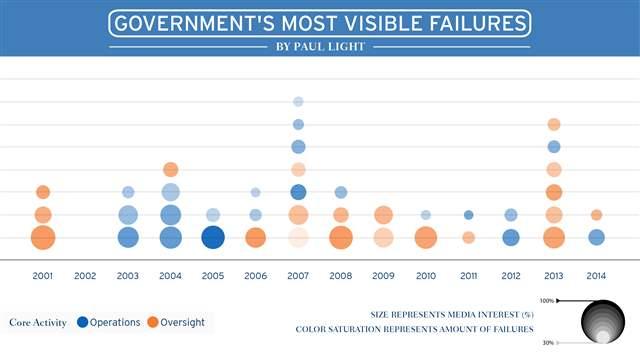Without Government Assistance They Are Likely to Continue to Fail
In this research paper, Paul C. Light writes that the "first step in preventing future failures is to find a reasonable set of past failures that might yield lessons for repair." To meet this goal, Light asks four key questions about past federal government failures: (1) where did government fail, (2) why did government fail, (3) who caused the failures, and (4) what can be done to fix the underlying problems?
WHERE GOVERNMENT FAILED
To answer the first question, Light identified and ranked 41 important past government failures (between 2001 – 2014) from a search of news stories listed in the Pew Research Center's "News Interest Index."
View our interactive on Government's Most Visible Failures, 2001-2014 »

Light finds the following patterns and characteristics in the dataset of significant government failures:
- Most of the failures involved errors of omission, not commission.
- Some failures were obviously more visible than others.
- Vision with execution is the clear driver of success, just as its absence is an equation for failure.
- Some of the stories contained elements of both success and failure.
- The number of government failures has increased over time
- There are differences between the five presidents in office during the failures. Government had four failures during Reagan's final two-and-a-half years (1.6 per year), five during George H. W. Bush's four years (1.2 per year), 14 during Clinton's eight years (1.8 per year), 25 during George W. Bush's eight years (3.1 per year), and 16 during Obama's first five-and-a-half years (2.9 per year).
- The differences are just large enough to suggest that government may be somewhat more likely to fail during the last few years of a two-term presidency, perhaps because presidents start to lose focus, appointees begin to turn over, the other party becomes more assertive, and the media becomes more aggressive.
- Government had just 10 failures during the Bush administration's first term (2.5 per year), but 15 failures during the administration's second (3.8 per year). In turn, government had just eight failures during the Obama administration's first term (2.0 per year), but matched its entire first-term total in just eighteen months of the second (5.3 per year).
- These failures involved both oversight and operations.
- More of the post-2001 government failures occurred during steady demand (27) than during surging demand (14), perhaps confirming the unconventional notion that surges sharpen organizational acuity.
WHY GOVERNMENT FAILED
Government can fail for many reasons, writes Light, including some that are well beyond its control. Poorly designed policies come from Congress and the president, for example, and may be impossible to implement regardless of bureaucratic commitment.
The contributors to failure fall into five categories, Light concludes:
- Policy: Government might not have been given the policy, or any policy at all, needed to solve the problem at hand; or the policy might have been either too difficult to deliver or delegated to a vulnerable or historically unreliable organization.
- Resources: Government might not have had enough funding, staff, or the "collateral capacity" such as information technology, oversight systems, or technical experience to deliver consistent policy impact.
- Structure: Government might have been unable to move information up and down its over-layered chain of command, select and supervise its contractors, or resolve the confusion associated with duplication and overlap.
- Leadership: Government's top appointees might have been unqualified to lead; could have made poor decisions before, during, and after the failures appeared; or might have taken their posts after long delays created by the presidential appointments process.
- Culture: Government might have created confusing missions that could not be communicated and embraced, were easily undermined by rank corruption and unethical conduct, or were beyond careful monitoring through performance measurement and management.
WHAT CONGRESS AND THE PRESIDENT CAN DO
What can the president and Congress do to avoid future cascades of failure? Light argues government actors must:
- Think about policy effectiveness from the start
- Provide the funding, staff, and collateral capacity to succeed
- Flatten the chain of command and cut the bloat
- Select presidential appointees for their effectiveness, not connections
- Sharpen the mission
The most powerful incentive for action could be, Light asserts, the delivery grades outlined above, especially if a failing grade came with a full stop on a prized proposal. Tied by rule to an automatic return-to-sender motion, these assessments could prompt Congress and the president to devote more attention to the intersection between vision and delivery.
Source: https://www.brookings.edu/research/a-cascade-of-failures-why-government-fails-and-how-to-stop-it/
0 Response to "Without Government Assistance They Are Likely to Continue to Fail"
Post a Comment